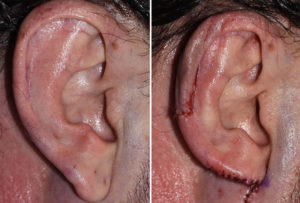Background: The large ear or Macrotia deformity is marked by an increase in vertical ear height. The length of the ear has been well described by anthropometric studies and in art by a variety of measurements and proportions. The ear is supposed to be roughly the angulation and length as that of the nose. Direct measurements describe an ear that is greater than 65mm long as being large. But numbers and proportions aside if a patient feels their ear is too big…then it is.
Macrotia reduction of the large ear is done by a ‘high and low’ approach. The bottom of the ear is shortened by earlobe reduction of which the inferior helical rim excision is usually the best technique. This creates little visible scar and is the ‘easiest’ part of macrotia reduction. The top of the ear is reduced by scaphal-helical rim cartilage resection through a pedicled scaphal flap technique. This is the ‘harder’ part of macrotia surgery to execute making sure most of the suture line hides well under the inner helical rim.
Despite the extensive nature of reduction surgery on the ear, scars are very minimal. The only obvious one is the small incision that crosses the helical rim in the center of the ear. All others are hidden under the helical rim and on the bottom side of the earlobe. But even the helical rim scar heals very well.
Case Study: This 40 year-old male presented for ear reduction surgery. He had very long ears that measured from the top of the helix to the bottom of the earlobe of 80mms on the right and 79mms on the left.

The effects of macrotia reduction are immediate and often dramatic. The ears do swell a bit and are mildly uncomfortable for a week to ten days. No dressings are used other than antibiotic ointment. Full healing can be expected in about 3 to 4 weeks.
Highlights:
1) Macrotia is almost always marked by both a large upper ear framework and a long earlobe.
2) The combination of a scaphal-helical rim reduction combined with earlobe shortening can make the ear 10 to 15mms vertically shorter.
3) Vertical earlobe reduction/reshaping can be performed under local anesthesia with or without IV sedation.
Dr. Barry Eppley
Indianapolis, Indiana



